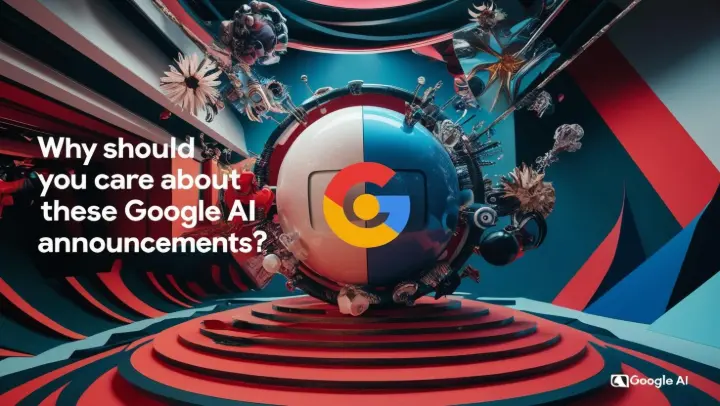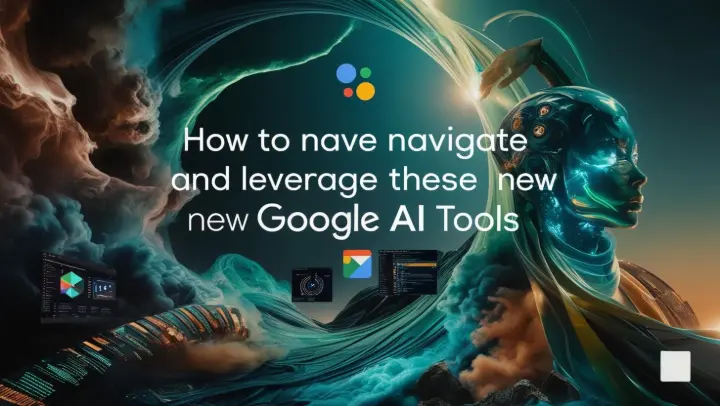20 Mind-Blowing Google I/O 2025 AI Updates Set to Revolutionize Your World
Feeling overwhelmed by the rapid pace of AI development? Wondering what Google's latest innovations mean for you and how they'll shape the future? You’re not alone. The tech world just witnessed a seismic shift with Google I/O 2025, an event that didn't just showcase new products, but painted a vivid picture of an AI-integrated tomorrow. If you're looking to understand the key Google I/O 2025 AI updates and how they promise to boost productivity, enhance creativity, and redefine our interaction with technology, you've come to the right place. This post will unpack the most significant announcements, moving beyond the hype to give you a clear view of what’s coming.
What Exactly Was Google I/O 2025 All About?
Think of Google I/O as the tech world's equivalent of a World's Fair, but focused entirely on the digital frontier. It's Google's annual flagship event where developers, creators, and tech aficionados get a firsthand look at the company's latest breakthroughs, particularly in artificial intelligence. This year, Google I/O 2025 was less about incremental updates and more about a fundamental leap forward, with AI woven into the fabric of nearly every announcement. It was a clear statement: Google is determined to bring its advanced AI research out of the labs and into the hands of millions, making complex technology accessible and impactful for everyday users and professionals alike. The central theme? Turning "research into reality."
Why Should You Care About These Google AI Announcements?

You might be thinking, "Okay, cool tech, but what's in it for me?" The answer is: a lot. These Google I/O 2025 AI updates aren't just for developers or Silicon Valley insiders. They represent tools and capabilities that will fundamentally change how you work, create, shop, and even perceive the world.
Imagine Sarah, a freelance graphic designer. A few years ago, creating a compelling video for a client meant expensive software, stock footage, and hours of editing. Now, with tools announced at Google I/O 2025, she might be able to generate stunning, realistic video clips complete with audio from a simple text prompt. This isn't just about saving time; it's about democratizing high-level content creation and unlocking new creative potential. For businesses, it means more efficient workflows, hyper-personalized customer experiences, and innovative product development. For individuals, it’s about smarter assistants, more intuitive search, and technology that genuinely understands and aids you. Staying informed isn't just about curiosity; it's about preparing for a future where AI is an indispensable partner.
The Craziest & Most Impactful AI Updates from Google I/O 2025
Google I/O 2025 was packed with announcements. While the script mentioned 20, let's dive into some of the most game-changing highlights that signal major shifts:
1. Revolutionizing Content Creation: VEO 3, Imagen 4 & Flow
The creative landscape is about to be terraformed. Google unveiled a trinity of tools poised to redefine video, image, and narrative creation:
- VEO 3: This isn't just another video generator. VEO 3 creates ultra-realistic videos with an understanding of real-world physics, and crucially, generates synchronized audio – background sounds, effects, and even dialogue. The launch video for I/O itself, crafted with VEO 3, was a testament to its power. This is a monumental step beyond current models that require separate audio generation.

- Imagen 4: Google's answer to sophisticated image generation, Imagen 4 impressed with its ability to accurately interpret text prompts, render complex text within images, and produce diverse artistic styles. It’s a significant leap in AI-driven visual art.
- Flow: Imagine a tool that takes VEO 3 and Imagen 4 and helps you weave them into complete, editable movie scenes and storyboards. Flow is a storytelling application that allows users to generate, extend, cut, and modify scenes seamlessly. This could empower individual creators to produce film-quality narratives previously requiring large teams and budgets.
What kind of stories or videos would you create if you had tools like VEO 3 and Flow at your fingertips? Drop your ideas in the comments!
2. The Gemini Ecosystem: Supercharged Intelligence Everywhere
Gemini, Google's multimodal AI model, received substantial upgrades and wider integration:
- Gemini 2.5 Model Family (Pro, Flash, Flash Light, Pro Deep Thinking): Google expanded its flagship AI model family, offering versions optimized for speed (Flash, Flash Light) and deep reasoning (Pro Deep Thinking). This means more power and flexibility for complex tasks in math, coding, and multimodal understanding. These models are designed to be the best in their class.
- Google Search AI Mode & Deep Research: Search is becoming an AI-powered conversational partner. The new AI mode, powered by Gemini 2.5, offers deeper research capabilities, browsing hundreds of websites to synthesize comprehensive answers, personalized with user context. No more endless clicking; get grounded, relevant information faster.
- Gemini Agent Mode: This feature allows Gemini to act on your behalf. For example, you could ask it to find apartments within a specific budget in your area, and it would autonomously browse sites like Zillow or 99acres, filter options, and present the best matches directly in the Gemini app. This is Project Mariner's capabilities coming to the forefront.
- Project Astra & Gemini Live: Your phone's camera becomes an intelligent eye. Point it at anything, and Gemini Live, powered by Project Astra, can identify objects, answer contextual questions (e.g., "What's this part of the speaker called?"), provide instructions, and even engage in reasoned dialogue about what it sees.
- Gemini in Chrome: A browsing assistant integrated directly into your Chrome browser. Ask questions about the webpage you're on, summarize content, or even ask it to perform tasks related to your Google Suite – all with a click.
(Visual Suggestion: A mock-up of the Gemini in Chrome interface, showing it assisting a user on a webpage.)
3. The Future of Interaction: Android XR Glasses & Google Beam
Google is pushing the boundaries of how we interact with the digital and physical worlds:
- Android XR Glasses: Forget the early attempts; these new AI-powered glasses aim to be your constant virtual assistant. Gemini will see what you see, provide real-time instructions, remember where you left your keys, and project directions onto your field of vision. Collaborations with brands like Wobby Parker suggest a serious consumer push.
- Google Beam (Project Starline Evolution): Tired of flat video calls? Google Beam offers a high-fidelity 3D meeting experience. Using a specialized display with multiple cameras, it captures a 3D representation of you, making virtual interactions feel remarkably in-person, complete with depth and natural presence.
4. AI in E-commerce & Daily Life: Agentic Checkout & Shopping Try-On
Shopping and daily tasks are getting smarter:
- Agentic Checkout: Imagine wanting an item but waiting for a sale. This feature notifies you of price drops, automatically adds the item to your cart (knowing your size preferences!), and lets you checkout with a single click. Seamless and efficient.
- Shopping Try-On Feature: Upload a photo of yourself and an image of a garment, and Google's AI will realistically superimpose the clothing onto your image, accurately predicting fit and drape. This could revolutionize online clothes shopping.
5. Democratizing Development & Creation: Stitch & Jules Coding Agent
Building apps and creating music is becoming accessible to more people:
- Stitch: Go from a text prompt to a designed, coded, and deployable app. Stitch generates wireframes and designs based on your idea, then writes the code. This aims to empower non-coders to bring their app visions to life.
- Jules Coding Agent: Google's AI coding assistant, akin to GitHub Copilot, helps create entire codebases, understand existing ones, and accelerate development from text to functional applications.
- Lirya 2: A music generation model showcased with composer Shankar Mahadevan, demonstrating how AI can assist even seasoned artists in creating music, making sophisticated tools usable for consumers.
6. Responsible AI: Synth ID & Pricing
With great power comes great responsibility (and cost):
- Synth ID: An invisible watermark embedded in AI-generated content (videos from VEO 3, images from Imagen 4, etc.) to help track and identify AI-made media. Google reported 10 billion pieces of content already carry this ID.
- Google AI Pricing: While many tools will have free tiers, Google also unveiled premium plans. A $20/month plan offers access to VEO 2 (likely a typo in script, probably meant earlier/lesser VEO or other tools) and Flow, while the "Google AI Ultra" plan at $250/month unlocks top-tier models like VEO 3, Imagen 4, and full agentic capabilities. This pricing strategy will be crucial in determining widespread adoption.
How to Navigate and Leverage These New Google AI Tools

The wave of Google I/O 2025 AI updates is exciting, but how can you practically prepare for and benefit from these advancements? Here’s a step-by-step approach:
- Identify Your Needs: Reflect on your professional role or personal interests. Are you a content creator (VEO 3, Flow, Imagen 4)? A developer (Stitch, Jules)? A marketer (Search AI Mode, Agentic features)? Pinpoint which tools could offer you the most significant advantages.
- Stay Informed & Explore Early Access: Keep an eye on the official Google AI Blog and Google Labs for announcements on public availability, beta programs, or developer previews. Many of these tools will roll out gradually.
- Embrace Experimentation: Once accessible, don't be afraid to dive in. Generative AI tools often require learning new prompting techniques. The more you experiment, the better you'll become at harnessing their power.
- Upskill and Adapt: Consider what new skills might be beneficial. This could range from prompt engineering to understanding AI ethics or learning how to integrate AI into existing workflows.
- Think Strategically About Integration: How can these tools not just replace tasks, but augment your capabilities or create entirely new opportunities? For businesses, this means rethinking processes and customer engagement strategies.
- Consider the Ethical Landscape: Be mindful of responsible AI use, data privacy, and the implications of tools like Synth ID. Engage with discussions around these topics to be a well-informed user.
Common Mistakes to Avoid with Emerging AI Technologies
As these powerful AI tools become more prevalent, it's easy to fall into common traps. Here are a few pitfalls to sidestep:
- Ignoring the Learning Curve: Many of these tools, despite their user-friendly interfaces, will require some learning and adaptation. Don't expect to master them overnight or think they'll magically solve all your problems without effort.
- Overlooking Ethical and Privacy Implications: With AI generating content, making decisions, and accessing personal data, don't use these tools blindly without considering their ethical impact or how they handle your data. Be particularly cautious with agentic systems.
- Waiting Too Long to Adapt: The tech landscape is shifting rapidly. Don't fall into the "wait and see" trap for too long, or you risk being left behind as competitors and peers adopt these efficiency-boosting technologies.
- Becoming Overly Reliant Without Critical Thinking: AI is a powerful assistant, but it's not infallible. Don't abdicate your critical judgment or decision-making entirely to AI. Always review, verify, and guide its outputs, especially in crucial tasks.
Final Thoughts
Google I/O 2025 wasn't just an event; it was a declaration of an AI-driven future that's arriving faster than many anticipated. From transforming content creation with VEO 3 and Flow to supercharging productivity with the enhanced Gemini ecosystem and even changing how we interact with the physical world via XR glasses, these Google I/O 2025 AI updates are set to make a profound impact. The key will be to approach these new technologies with curiosity, a willingness to learn, and a mindful consideration of their broader implications.
Which of these Google AI updates are you most excited or intrigued by? What potential do you see for them in your field or daily life? Share your thoughts and biggest takeaways in the comments below
The official Google Blog Blog Google for direct links to specific announcements or product pages related to I/O 2025.